Sadegh Hedayat
| Sādegh Hedāyat | |
|---|---|
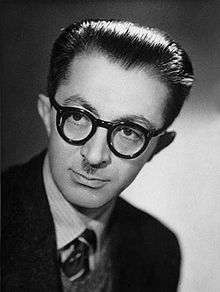 The last photograph he posted from Paris to his relatives in Tehran.(1951) | |
| Born |
Sādegh Hedāyat 17 February 1903 Tehran, Iran |
| Died |
9 April 1951 (aged 48) Paris, France |
| Nationality | Iranian |
| Known for | Writer of prose fiction and short stories |
| Notable work |
The Blind Owl (Boof-e koor) |
Sadegh (also spelled as Sadeq) Hedayat (Persian: صادق هدایت Persian pronunciation: [ˈsɑːdəq hədɑːˈjæt] ![]()
Life
Hedayat was born to a northern Iranian aristocratic family in Tehran (his great-grandfather Reza-Qoli Khan Hedayat was himself a well respected writer and worked in the government, as did other relatives) and was educated at Collège Saint-Louis (French catholic school) and Dar ol-Fonoon (1914–1916). In 1925, he was among a select few students who travelled to Europe to continue their studies. There, he initially went on to study engineering in Belgium, which he abandoned after a year to study architecture in France. There he gave up architecture in turn to pursue dentistry. In this period he became acquainted with Thérèse, a Parisian with whom he had a love affair. In 1927 Hedayat attempted suicide by throwing himself into the Marne, but was rescued by a fishing boat. After four years in France, he finally surrendered his scholarship and returned home in the summer of 1930 without receiving a degree. In Iran he held various jobs for short periods.
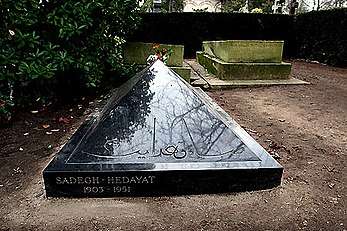
Hedayat subsequently devoted his whole life to studying Western literature and to learning and investigating Iranian history and folklore. The works of Rainer Maria Rilke, Edgar Allan Poe, Franz Kafka, Anton Chekhov and Guy de Maupassant intrigued him the most. During his short literary life span, Hedayat published a substantial number of short stories and novelettes, two historical dramas, a play, a travelogue, and a collection of satirical parodies and sketches. His writings also include numerous literary criticisms, studies in Persian folklore, and many translations from Middle Persian and French. He is credited with having brought Persian language and literature into the mainstream of international contemporary writing. There is no doubt that Hedayat was the most modern of all modern writers in Iran. Yet, for Hedayat, modernity was not just a question of scientific rationality or a pure imitation of European values.
In his later years, feeling the socio-political problems of the time, Hedayat started attacking the two major causes of Iran's decimation, the monarchy and the clergy, and through his stories he tried to impute the deafness and blindness of the nation to the abuses of these two major powers. Feeling alienated by everyone around him, especially by his peers, Hedayat's last published work, The Message of Kafka, bespeaks melancholy, desperation and a sense of doom experienced only by those subjected to discrimination and repression.

Hedayat traveled and stayed in India from 1936 until late 1937, the mansion at Bombay where he was staying during his visit at Bombay has been recently discovered in 2014. Nadeem Akhtar's Hedayat in India [1] provides us details of Sadegh Hedayat's sojourn in India. In Bombay he completed and published his most enduring work, The Blind Owl, whose writing he started as early as 1930 in Paris. The book was praised by many including Henry Miller, André Breton and others. It has been called "one of the most important literary works in the Persian language".[2]
At the end of 1950, Hedayat left Iran for Paris. There, on 9 April 1951, he committed suicide by gassing himself in a small rented apartment on 37 Rue Championnet. He had plugged all the gaps in the windows and door with cotton and, so it would not burden anyone, he had placed the money (a hundred thousand francs) for his shroud and burial in his side wallet in plain view. He was buried at the division 85 of Père Lachaise Cemetery. His funeral was attended by a number of intimate friends and close acquaintances, both Iranian and French.
The English poet John Heath-Stubbs published an elegy, 'A Cassida for Sadegh Hedayat', in A Charm Against the Toothache in 1954.
Current censorship
His work is coming under increasing attack in Europe from political Islamists. The novels The Blind Owl and Haji Aqa were banned from the 18th Tehran International Book Fair in 2005. In Haji Aqa his characters explore the lack of meritocracy in Iran:
In order for the people to be kept in line, they must be kept hungry, needy, illiterate, and superstitious. If the grocer's child becomes literate, he not only will criticize my speech, but he will also utter words that neither you nor I will understand.... What would happen if the forage-seller's child turns out intelligent and capable—and mine, the son of a Haji, turns out lazy and foolish?
In November 2006, republication of Hedayat's work in uncensored form was banned in Iran, as part of a sweeping purge. However, surveillance of book-stalls is limited and it is apparently still possible to purchase the originals second-hand. The official website is also still online. Some material discussing the issue of censorship include:
- Item[3] in The Guardian from November 2006
- "City Report: Tehran"[4] from Frieze, issue 86, October 2004, discussing Iranian censorship in general
- Article[5] by Radio Free Europe — Radio Liberty from November 2007
Works
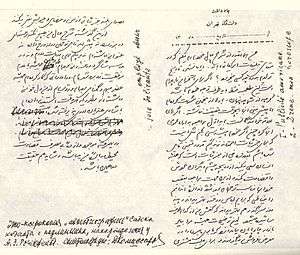
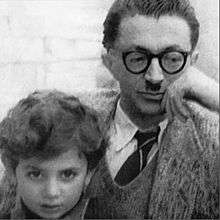
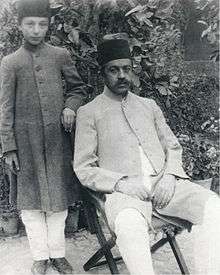
- Fiction
- 1930 Buried Alive (Zende be gūr). A collection of 9 short stories.
- 1931 Mongol Shadow (Sāye-ye Moqol)
- 1932 Three Drops of Blood (Se qatre khūn). A collection of 11 short stories.
- 1933 Chiaroscuro (Sāye-ye roushan). A collection of 7 short stories.
- 1934 Mister Bow Wow (Vagh Vagh Sahāb)
- 1936 Sampingé (in French)
- 1936 Lunatique (in French)
- 1936 The Blind Owl (Boof-e koor)
- 1942 The Stray Dog (Sag-e velgard). A collection of 8 short stories.
- 1943 Lady Alaviyeh (Alaviye Khānum)
- 1944 Velengārī (Tittle-tattle)
- 1944 The Elixir of Life (Āb-e Zendegi)
- 1945 The Pilgrim (Hājī āqā)
- 1946 Tomorrow (Fardā)
- 1947 The Morvari Cannon (Tūp-e Morvari)
- Drama (1930–1946)
- Parvin dokhtar-e Sāsān (Parvin, Sassan's Daughter)
- Māzīyār
- Afsāne-ye āfarīnesh (The Fable of Creation)
- Travelogues
- Esfahān nesf-e jahān (Isfahan: Half of the World)
- Rū-ye jādde-ye namnāk (On the Wet Road), unpublished, written in 1935.
- Studies, Criticism and Miscellanea
- Rubāyyāt-e Hakim Omar-e Khayyam (Khayyam's Quatrains) 1923
- Ensān va heyvān (Man and Animal) 1924
- Marg (Death) 1927
- Favāyed-e giyāhkhori (The Advantages of Vegetarianism) 1927
- Hekāyat-e bā natije (The Story with a Moral) 1932
- Taranehā-ye Khayyām (The Songs of Khayyam) 1934
- Chāykovski (Tchaikovsky) 1940
- Dar pirāmun-e Loqat-e Fārs-e Asadi (About Asadi's Persian Dictionary) 1940
- Shive-ye novin dar tahqiq-e adabi (A New Method of Literary Research) 1940
- Dāstan-e Nāz (The Story of Naz) 1941
- Shivehā-ye novin dar she'r-e Pārsi (New Trends in Persian Poetry) 1941
- A review of the film Molla Nasrud'Din 1944
- A literary criticism on the Persian translation of Gogol's The Government Inspector 1944
- Chand nokte dar bāre-ye Vis va Rāmin (Some Notes on Vis and Ramin) 1945
- Payām-e Kāfkā (The Message of Kafka) 1948
- Al-be`thatu-Islamiya ellal-belad'l Afranjiya (An Islamic Mission in the European Lands), undated.
- Translations
- From French:
- 1931 Gooseberries by Anton Chekhov
- 1948 In the Penal Colony by Franz Kafka
- 1944 Before the Law by Franz Kafka
- 1950 The Metamorphosis by Franz Kafka (along with Hasan Qaemian)
- 1950 The Wall by Jean-Paul Sartre
- 1950 Tales of Two Countries by Alexander Kielland
- 1950 Blind Geronimo and his Brother by Arthur Schnitzler
- From Pahlavi:
- 1943 Kārname-ye Ardashir-e-Pāpākān (The Book of the Deeds of Ardashir [son of] Papakan)
- 1940 Gojaste Abālish
- 1945 Āmadan-e shāh Bahrām-e Varjavand (Return of shah Bahram Varjavand)
- 1944 Zand va Homān Yasn
- From French:
Films about Hedayat
- In 1987 Raul Ruiz made the feature film La Chouette aveugle in France: a loose adaption of Hedayat's novel The Blind Owl. Its formal innovations led critics and filmmakers to declare the film 'French cinema's most beautiful jewel of the past decade.'[6]
- Hedayat's last day and night was adapted into the short film, The Sacred and the Absurd, directed by Ghasem Ebrahimian, which was featured in the Tribeca Film Festival in 2004.
- In 2005 Iranian film director Khosrow Sinai has made a docudrama about Hedayat entitled Goftogu ba saye = Talking with a shadow. Its main theme is the influence of Western movies such as Der Golem, Nosferatu and Dracula on Hedayat.
- In 2009, Mohsen Shahrnazdar and Sam Kalantari made a documentary film about Sadegh Hedayat named From No. 37.
See also
Sources
- Hassan Kamshad, Modern Persian Prose Literature ISBN 0-936347-72-4
- Acquaintance with Sadegh Hedayat, by M. F. Farzaneh, Publisher: Markaz, Tehran, 2008.
- Sadeq Hedayat, the foremost short story writer of Iran
- The Sacred and the Absurd, a film about Hedayat's death
Further references
- Homa Katouzian, Sadeq Hedayat: Life and legend of an Iranian writer, I.B. Tauris, 2000. ISBN 1-86064-413-9
- Hassan Kamshad, Modern Persian Prose Literature, Ibex Publishers, 1996. ISBN 0-936347-72-4
- Michael C. Hillmann, Hedayat's "The Blind Owl" Forty Years After, Middle East Monograph No. 4, Univ of Texas Press, 1978.
- Iraj Bashiri, Hedayat's Ivory Tower: Structural Analysis of The Blind Owl, Minneapolis, Minnesota, 1975.
- Iraj Bashiri, The Fiction of Sadeq Hedayat, 1984.
- Sayers, Carol, The Blind Owl and Other Hedayat Stories, Minneapolis, Minnesota, 1984.
- What is left for me from Sadegh Hedayat? Excerpt from "Sadegh Hadayat: Dar Tare Ankaboot" (In the Spider's Web), by M. F. Farzaneh, 2005.
- Hedayat's last night out in Paris Excerpt from M. F. Farzaneh's "Ashenayee ba Sadegh Hedayat" (Knowning Sadegh Hedayat), 2004.
References
- ↑ electricpulp.com. "HEDAYAT, SADEQ v. Hedayat in India – Encyclopaedia Iranica". www.iranicaonline.org. Retrieved 2015-09-03.
- ↑ "From Persia to Tehr Angeles: A Contemporary Guide to Understanding and Appreciating Ancient Persian Culture", p. 126, by Kamran Sharareh
- ↑ Robert Tait in Tehran (2006-11-17). "Bestsellers banned in new Iranian censorship purge | World news". The Guardian. Retrieved 2013-09-26.
- ↑ "Frieze Magazine | Archive | Tehran". Frieze.com. Archived from the original on 2013-10-01. Retrieved 2013-09-26.
- ↑ "Iran: Book Censorship The Rule, Not The Exception". Rferl.org. 2007-11-26. Retrieved 2013-09-26.
- ↑ "Excerpted from Trafic no. 18 (Spring 1996) Translation Rouge 2004".
External links
| Wikimedia Commons has media related to Sadeq Hedayat. |
| Wikiquote has quotations related to: Sadegh Hedayat |
- Sadeq Hedayat's Life by Iraj Bashiri.
- Sadeq Hedayat's Corner, further articles and English translations by Iraj Bashiri.
- Persian Language & Literature — Sadeq Hedayat.
- A Tribute to Sadeq Hedayat.
- Hedayat Page (in French).
- Sokhan — online literary magazine (in Persian).
- Hedayat's art work
- Sadegh Hedayat at Find a Grave
- Audiobooks (Ketab-e Gooya).
- Tup-e Morvari by Sadeq Hedayat (in Persian), (PDF), (The Iranian).
- Hedayat Family History (in English).
- Sadeq Hedayat's Heritage, Jadid Online, 17 July 2008 (in English).
- A Museum That Was Not To Be, by Mahtāj Rasuli, Jadid Online, 20 June 2008 (in Persian).
- An audio slideshow (with English subtitles) by Shokā Sahrāi, with Mr Jahāngir Hedayat (son of General Isā Hedayat, Sadegh Hedayat's brother) speaking. (6 min 28 sec).
- The Stray Dog (short story) Translated by Brian Spooner
- Buried Alive (Short Story) Translated by Carter Bryant
- The Elixir of Life (Short Story) Translated by Kambiz Parsai
- The Darkroom (Short Story) Translated by Kambiz Parsai
- Daash Akol (Short Story) Translated by Kambiz Parsai
- Davood the Hunchback (Short Story) Translated by Mohammad Rajabpur